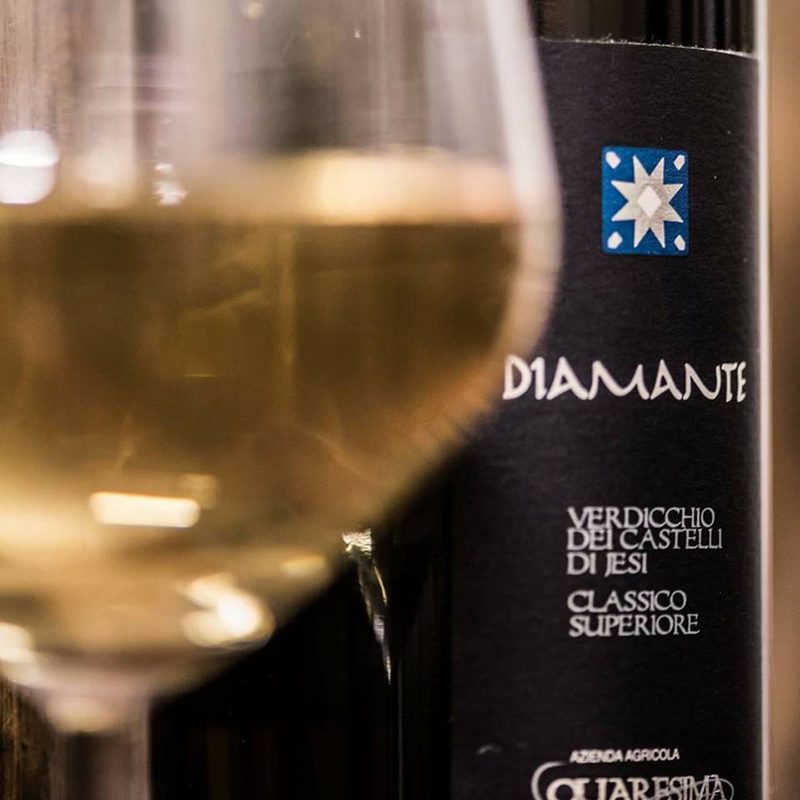{:it}Diamante – Verdicchio DOC Classico Superiore (Az Agricola Quaresima)
di Massimiliano Giorgi
Anche il più campanilista vignaiolo della Vallesina è costretto a riconoscere che Cupramontana è il cuore della terra del Verdicchio. Verdicchio vuol dire Marche, ne è l’ambasciatore sulle tavole nel mondo, è stata la prima DOC di questa regione.
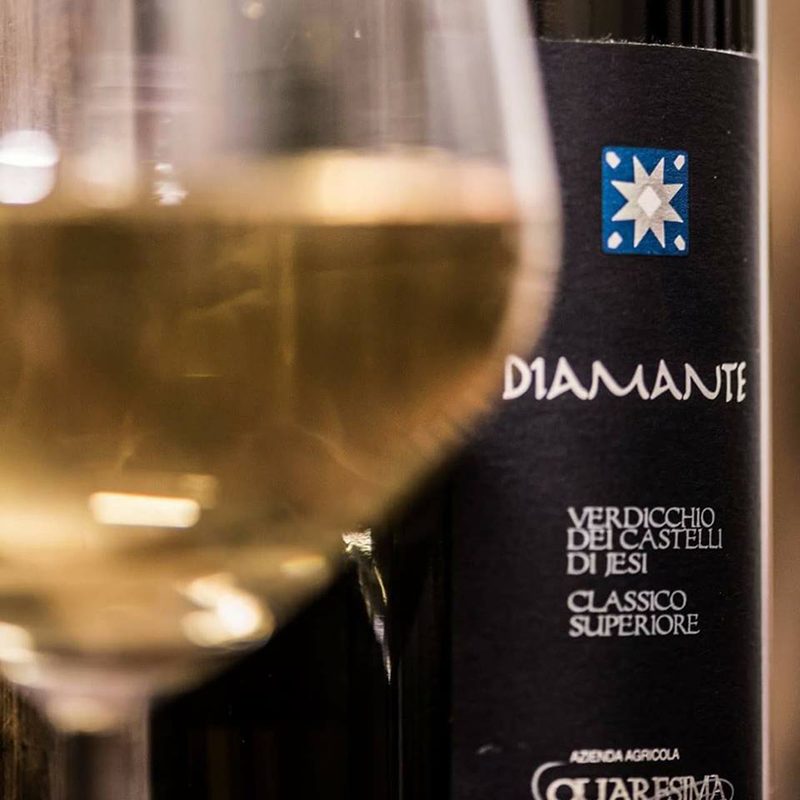 Qua la vite si coltiva da più di 1200 anni. Forse nell’800 (si, senza il mille davanti) non lo chiamavano ancora Verdicchio, ma è in quegli anni che si installano i primi “cuprensi” a coltivare uva in quella che oggi è contrada Morella, nella zona di S. Michele, e a far di quelle uve il nonno del Verdicchio.
Qua la vite si coltiva da più di 1200 anni. Forse nell’800 (si, senza il mille davanti) non lo chiamavano ancora Verdicchio, ma è in quegli anni che si installano i primi “cuprensi” a coltivare uva in quella che oggi è contrada Morella, nella zona di S. Michele, e a far di quelle uve il nonno del Verdicchio.
È alla Morella che oggi la famiglia Quaresima fa nascere il Diamante.
Lo chiamano Diamante, i Quaresima, perché è l’eccellenza della loro produzione: quest’anno 2016 ha dato appena 2661 bottiglie di Diamante (comunque il doppio della scorsa annata, tutte le bottiglie numerate e firmate una ad una.
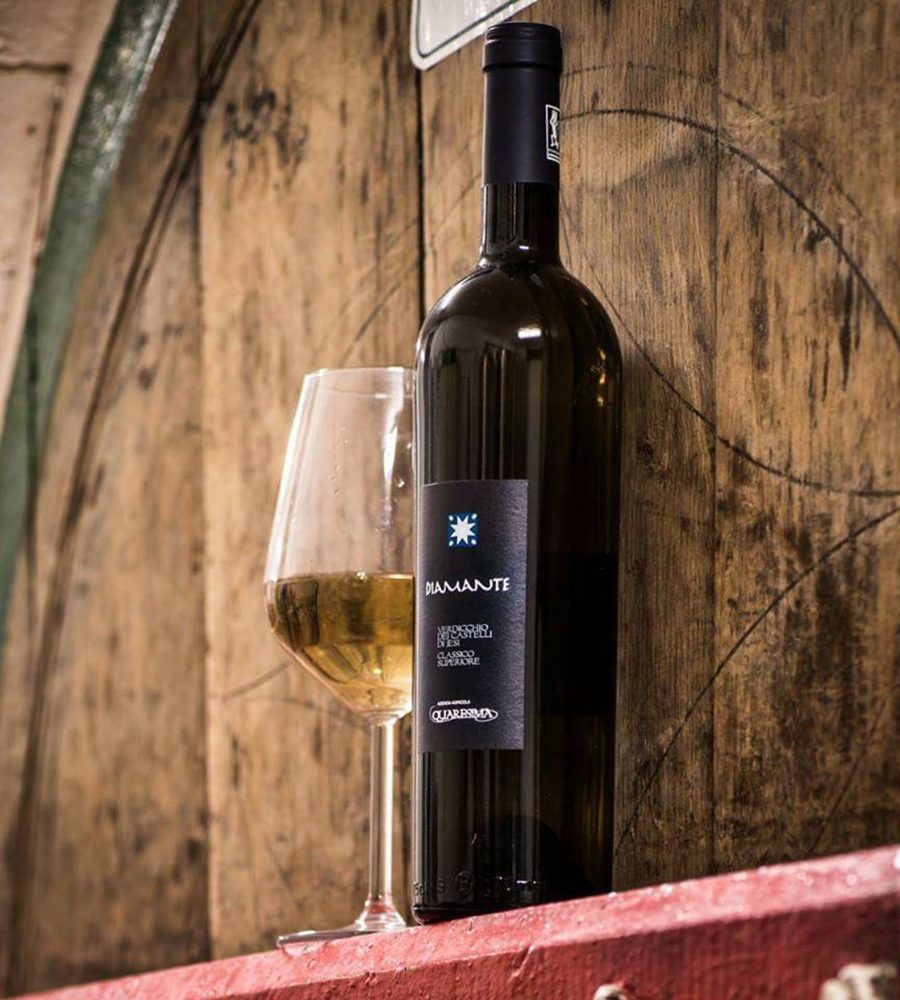 Uve selezionate e non per modo di dire: S. Michele è identificato come il primo e più importante terroir a Cupramontana; per il Diamante si coltiva il vigneto più a nord della Contrada Morella, un suolo calcareo e argilloso a 450 metri slm, rivolto a a Sud-Est. Vengono scelti solo i 2 grappoli migliori del ceppo madre e si vinifica prendendo solo il mosto fiore e passato su presse a membrana. Il Diamante fermenta per 20-30 giorni a 18°C e matura per altri sei mesi: dalle botti esce un Verdicchio dal tipico color paglierino con riflessi verdi, ad oltre 14 ° alcolici.
Uve selezionate e non per modo di dire: S. Michele è identificato come il primo e più importante terroir a Cupramontana; per il Diamante si coltiva il vigneto più a nord della Contrada Morella, un suolo calcareo e argilloso a 450 metri slm, rivolto a a Sud-Est. Vengono scelti solo i 2 grappoli migliori del ceppo madre e si vinifica prendendo solo il mosto fiore e passato su presse a membrana. Il Diamante fermenta per 20-30 giorni a 18°C e matura per altri sei mesi: dalle botti esce un Verdicchio dal tipico color paglierino con riflessi verdi, ad oltre 14 ° alcolici.
Le caratteristiche del Verdicchio classico fin qui ci son tutte. Ma quando apriamo la bottiglia viene fuori la particolarità, come si confà ad ogni cru.
Per me – adoratore del Verdicchio più duro possibile, con aromi e sapori netti e forti – il Diamante è una piacevole sorpresa: è quel perfetto equilibrio per chi non ama il Classico (perché il Diamante sembra avere solo l’etichetta del Classico Superiore), ma non è ancora l’impegnativo Riserva, che ti spinge a meditazioni da “corksniffer”.
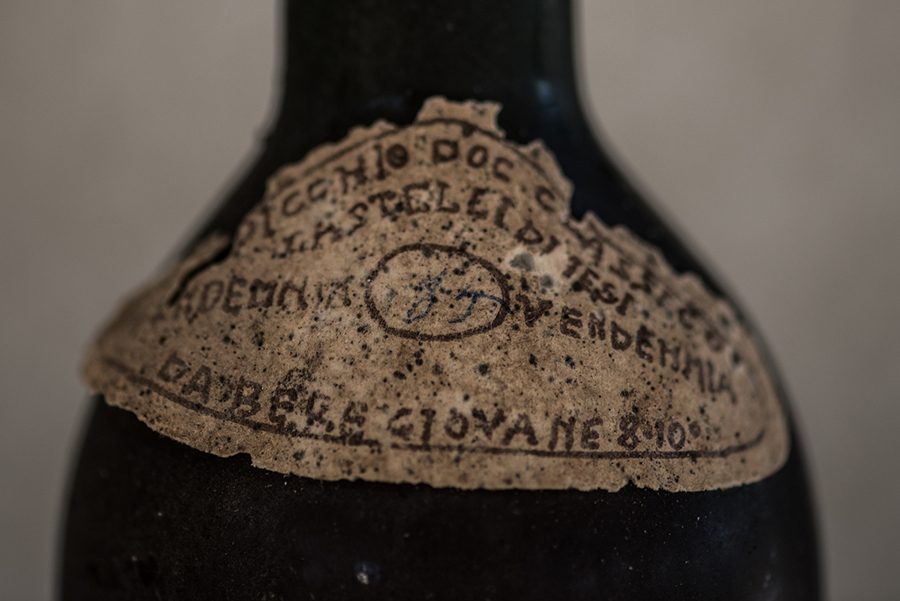 È il frutto di una storia di famiglia e lo dimostrano il Diamante e gli sguardi e le parole dei Quaresima: brillano gli occhi a Fabrizio Quaresima quando ci fa entrare nella cucina della nonna.
È il frutto di una storia di famiglia e lo dimostrano il Diamante e gli sguardi e le parole dei Quaresima: brillano gli occhi a Fabrizio Quaresima quando ci fa entrare nella cucina della nonna.
Letteralmente: è stata lasciata intatta e funzionante all’interno dell’azienda agricola, così com’era decenni fa. Qui vi può capitare, in una di quelle giornate dove organizzano una tavolata o una degustazione, o uno dei tanti eventi guidati che si fanno per le nostre cantine, di sentire i profumi di quella cucina di casa che noi marchigiani – tutti! – abbiamo impressi nella memoria.
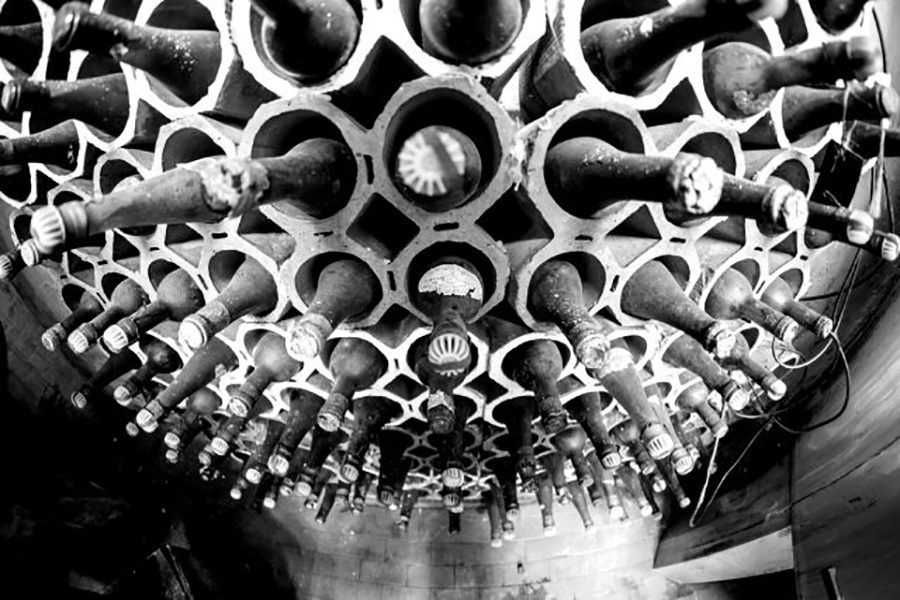 Brillano gli occhi a Fabrizio, quando ci racconta dei pranzi della domenica cucinati dalla nonna, in quello stesso luogo, mentre apre una ad una le bottiglie e ce le fa assaggiare (il verdicchio Filello, poi lo Zuave, fatto con le albicocche, e poi poteva mancare il vino di Visciola?), raccontando una ad una i sapori, dove sta la vigna con cui è fatto, il nome di chi cura le piante: “Dove cresce l’uva per il Diamante nonno non mi ci fa neanche avvicinare e penso mi prende a palate se mi ci trova!”. Ancora qualche decennio, pare, prima che si possa passare tutti i segreti di famiglia, le “ricette”. Si, perché on basta scrivere “Verdicchio”, o “Visciola” per avere un buon prodotto, men che meno qualcosa di superiore ai tanti già assaggiati.
Brillano gli occhi a Fabrizio, quando ci racconta dei pranzi della domenica cucinati dalla nonna, in quello stesso luogo, mentre apre una ad una le bottiglie e ce le fa assaggiare (il verdicchio Filello, poi lo Zuave, fatto con le albicocche, e poi poteva mancare il vino di Visciola?), raccontando una ad una i sapori, dove sta la vigna con cui è fatto, il nome di chi cura le piante: “Dove cresce l’uva per il Diamante nonno non mi ci fa neanche avvicinare e penso mi prende a palate se mi ci trova!”. Ancora qualche decennio, pare, prima che si possa passare tutti i segreti di famiglia, le “ricette”. Si, perché on basta scrivere “Verdicchio”, o “Visciola” per avere un buon prodotto, men che meno qualcosa di superiore ai tanti già assaggiati.
E il Diamante non me lo fai sentire? Chiedo petulante a Fabrizio. “No, te lo porti a casa e poi mi dici” è la risposta.
Ho aspettato qualche giorno, preparando le papille (leggi: smesso il toscano, ritornato ai più soavi Habanos) e poi, azzardando, invece d’andar sul sicuro con una fritturina di pesce (“col Verdicchio è la morte sua” si dice, concordano anche gli avversari storici anconetani!); ho azzardato dei banali maccheroni, affogati su un ragù. Il “sugo del batte”, quanto di più marchigiano ci sia, quello che si preparava in campagna durante la battitura del grano. Eh sì, perché un grande Verdicchio si sposa con tutto
Vitigni: 100% Verdicchio.
- Zona di provenienza:Cupramontana (AN).
- Densità di impianto:1000 viti/ha.
- Sistema di allevamento:
- Età media delle viti:25 anni.
- Resa per ettaro:33 quintali di uva.
- Bottiglie prodotte:700
- Gradazione alcolica:14,2 °C.
- Vinificazione:in bianco.
- Fermentazione:30 giorni.
- Maturazione: 6 mesi.
- Colore:Giallo paglierino scarico con spiccati riflessi verdi.
{:}{:en}Diamante – Verdicchio DOC Classico Superiore (Farm Quaresima)
Even the most parochial among wine producer of the Vallesina has to acknowledge that Cupramontana is the heart of the territory of wine grape variety Verdicchio. Verdicchio means Marche, it is actually an ambassador on the tables all around the world, and was the first DOC (Denominazione di Origine Controllata) to be certified in this region.
Vineyards have been cultivated there for more than 1200 years. Maybe in the Ninth century it was not called Verdicchio, but it was in that century that the first inhabitants in Cupramontana settled down and farmed vine in Contrada Morella, in the area S. Michele, and those grapes became the grandfather of Verdicchio.
Nowadays it is in fact in Contrada Morella that family Quaresima produces Diamante.
The farmers Quaresima named the wine Diamante, since this is an excellence among their products: in 2016 only 2661 bottles of Diamante were produced (production was doubled compared to the previous year), each bottle is numbered and signed one by one.

Selected grapes actually: S. Michele is registered as the first and most important terroir in Cupramontana; Diamante is produced on the vineyard on the north side of Contrada Morella, its soil is chalky and clayish, 450 meter above sea level, South-East facing.
Only the best 2 bunches of the main vine log are chosen and wine is made out of the first must and seep into membrane wine press. Diamante ferments for 20-30 days at a temperature of 18°C and then rests for six months: Verdicchio with its typical straw yellow and green shades comes out of the barrel, 14° of alcohol.
It includes all the main features of typical Verdicchio, but it is not enough. When you open the bottle, its peculiarity comes to life, as it happens for every Cru.
For me – a strong Verdicchio enthusiast, particularly of wine with strong and definite aroma and taste – Diamante is a pleasant surprise: it represents a perfect balance for those who do not appreciate Classico (Diamante seems to have only a label of Classico Superiore), but it is not yet too demanding as Riserva that would request “corksniffer” meditation.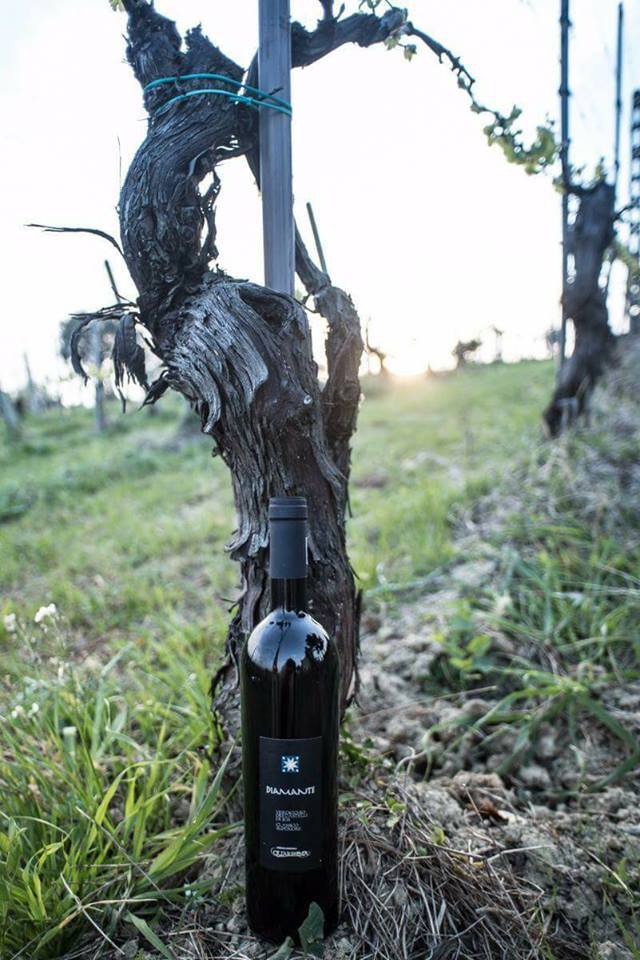
It is the result of the history of a family, and Diamante demonstrates that, and also the gaze and the words of Quaresima: Fabrizio Quaresima’s eyes twinkle when he shows his grandma’s kitchen to us.
Literally: it was kept untouched and useable inside the farm, as it used to be in the past decades. There you could smell the real taste of the kitchen of the homes of the Marche, that everyone there know well, maybe during the tasting events or the tours in the wine cellar.
Fabrizio’s eyes twinkle when he tells about the Sunday lunch prepared with love by his grandma, in that same place, while he opens a bottle and lets us taste some good wine (Verdicchio Filello, then Zuave made with apricots, and then the special sour cherry wine), telling one by one the taste of the place where the vineyard is located, the name of the one who takes care of the plants: “Grandpa does not even allow me to go near to the grapes used to produce the Diamante, he would certainly beat me up, if he finds me nearby!”. Still few decades before he would transfer the family secrets, the “recipes”. It is not enough to label a wine as “Verdicchio” or “Sour Cherry Wine” to have a good product, and not even to have a better product compared to the many tasted wines.
Won’t you let me taste the Diamante, please? I harass Fabrizio. “No, bring the wine home and then you tell me about it” was his answer.
I waited few days, trying to prepare my palate (read as: stop smoking Toscano cigar, and back to smoking Habanos) and then I dare eating fried fish (“Verdicchio is the perfect match to it”, and also historical fellow enemies from Ancona would agree!); I risked with some common macaroni with ragu. The traditional “sugo del batte (meat sauce)” typical in the region Marche, that was the dish eaten by farmers after the threshing. A great Verdicchio matches with all dishes, indeed.
Technical data
Variety of grapes: 100% Verdicchio
Production zone: Cupramontana (AN) Italy
Density of plants: 1000 vines per hectare
Growing system: ropes
Age of vines: 25 years
Yield per hectare: 3.300 kg of grapes
Produced bottles: 700
Alcohol: 14.2 °
Winemaking: white vinification
Fermenting: 30 days
Ageing: 6 months
Color: light straw yellow and marked green shades
{:}

